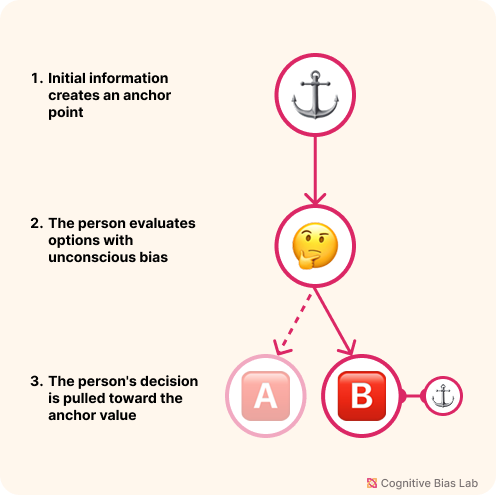Anchoring Bias
Your progress on this bias test won't be saved after you close your browser.
Understanding Anchoring Bias
Anchoring Bias
Our tendency to fixate on the first piece of information we encounter can heavily skew our decisions.
What is Anchoring Bias?
Anchoring bias is a cognitive shortcut where individuals rely too heavily on the first piece of information they receive (the "anchor") when making decisions. This initial reference point can significantly influence judgment, even when it is arbitrary or unrelated.
How It Works
When an anchor is introduced, whether it is a number, statement, or suggestion, it becomes a mental reference point. Subsequent judgments are made by adjusting away from this anchor rather than evaluating from a neutral starting point. This adjustment tends to be incomplete, leading to biased outcomes.
For instance, if you see a pair of shoes marked down from $200 to $80, the original price frames your perception. You might view $80 as a great deal, even if similar shoes normally cost $60 elsewhere. Anchoring applies to prices, time estimates, salary negotiations, and more.
Psychological Mechanism
Anchoring occurs because the brain seeks efficiency. Starting from a given reference point and adjusting from there requires less cognitive effort than building an estimate from scratch. However, the adjustments we make are often insufficient, especially when we lack domain knowledge or are under pressure.
Even minimal exposure to a number or concept can set an anchor. Once it is set, it is surprisingly hard to disregard, even when we recognize it might be irrelevant or misleading.
Why It Matters
Anchoring bias can:
- Distort how we value products, services, or investments
- Bias decisions during negotiations or salary discussions
- Influence risk assessments and probability estimates
- Affect judgments in legal, medical, or business settings
Understanding how anchoring works allows individuals and organizations to make more rational, data-driven decisions. It is especially important in environments where clear thinking and accurate judgment are critical.

Visual representation of Anchoring Bias (click to enlarge)
Examples of Anchoring Bias
Here are some real-world examples that demonstrate how this bias affects our thinking:
Psychological Study Simulation
The Anchoring Effect
Experience how random numbers can unconsciously influence your judgments in this recreation of Tversky & Kahneman's famous experiment.
Car Showroom Price Contrast
You walk into a showroom and first see a luxury car priced at $300,000. Later, when viewing a $23,000 Toyota, it seems like a bargain. This perception does not come from the Toyota being a great value, but from your judgment being anchored by the much higher initial price.
Freelance Contract Negotiation
A freelancer quotes $10,000 for a job that typically costs around $7,000. Even after researching and finding that market rates are lower, you agree to $8,500. Your mind remains influenced by the original anchor, leading you to accept a price that is still above average.
How to Overcome Anchoring Bias
Here are strategies to help you recognize and overcome this bias:
Gather Diverse Data
Collect multiple independent estimates and historical benchmarks before making decisions. This offsets the impact of the initial anchor and gives a more balanced foundation for judgment.
Structured Decision Processes
Use systematic tools such as checklists, weighted criteria, or blind assessments. These help to prevent the first piece of information from dominating your reasoning.
Test Your Understanding
Challenge yourself with these questions to see how well you understand this cognitive bias:
You're evaluating a candidate for a job. The first thing you notice is their unusually high current salary. How might anchoring bias affect your judgment?
Academic References
- Tversky, A., & Kahneman, D. (1974). Judgment under Uncertainty: Heuristics and Biases. Science, 185(4157), 1124–1131.
- Schley, D. (2023). 50 Years of Anchoring: A Meta-Analysis and Meta-Study of Anchoring Effects. SSRN Electronic Journal.
- Yasseri, T., & Reher, J. (2022). Fooled by facts: quantifying anchoring bias through a large-scale experiment. Journal of Computational Social Science, 5(1), 1001–1021.